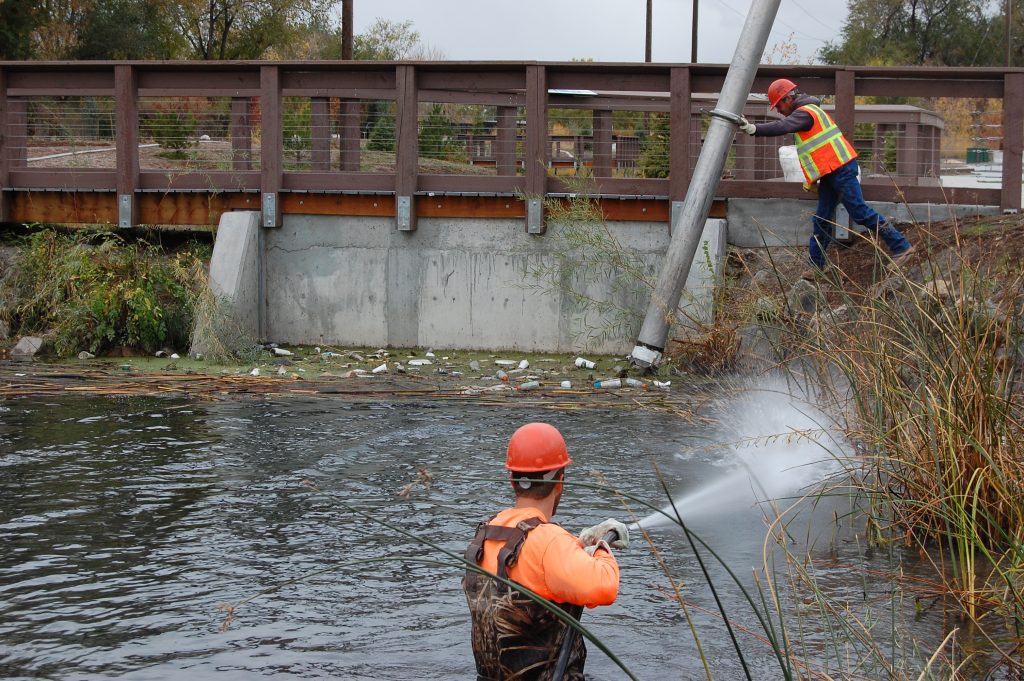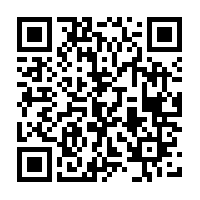Flood Control: Maintaining and managing our stormwater system
Stormwater management is essential in reducing localized flooding, and it improves water quality in our streams and lakes. Public Utilities has built and maintains an intricate storm drain system throughout the City. We routinely clean these drains and monitor for storm drain pollution from contaminated runoff from streets, sidewalks, businesses, yards and gutters.
We also educate the public on keeping toxic and hazardous materials from running into storm drains and ultimately harming our water. It’s a fact: We all live downstream.

Flood control is directly linked to stormwater management. Clogged storm drains can lead to localized flooding. We work together with federal, state and county agencies on flood control, including educating and assisting the public in the event of flooding.
Public Utilities takes a two-pronged approach to helping residents and business owners. First, we work to prevent or reduce the risk of damage from floods, and second, we work closely with other agencies to ensure the community has all the information and assistance needed in the event of a flood. Our Department works in cooperation with the Federal Emergency Management Agency (FEMA), which identifies and designates flood zones, and the National Flood Insurance Program (NFIP), which offers flood insurance to home or business owners located in FEMA Special Flood Hazard Areas (SFHAs).
Public Utilities can help you determine if your property is in a flood zone, help you understand the federal rules and regulations regarding developed properties within flood zones, and help with options regarding development in a flood zone. We also will work with consulting licensed professionals to assist in any remapping or flood control measure that may reduce the risk of flood damage. In addition to the FEMA areas, the Utility helps address local flooding issues due to rain storms, snow melt, or groundwater, through our stormwater management program to minimize damage or accidents related to flooding.
The community can help by reporting localized flooding problems as soon as possible. This will allow our crews to take immediate action and to avoid future problems. Please call our emergency dispatch center at 801-483-6700 to report flooding.
The following sites and documentation may assist you:
Visit the FEMA Map Service Center site to search flood insurance rate maps, to determine flooding hazards and FEMA flood zone determination.
http://www.floodsmart.gov (LINK) Citizen portal for FEMA with excellent resources regarding floodzones, insurance, and how the remapping process works.
Find out how to buy flood insurance.
Emergency Management and Assistance (LINK) The FEMA website for the regulations regarding Special Flood Hazard Areas (SFHAs). Sections 60.1 through 60.3 are the general areas of interest. Note that SLC Code (Chp 18.68) does not allow the Variances as discussed in Section 60.6.
Salt Lake City Code Chapter 18.68 supports certain floodplain regulations. Note that specifics in the City code may trump the general regulations found in the federal code. While the City code may have requirements more stringent, it may not be more lenient than the federal code. As a general rule, the code which is more strict will govern.
Information at Salt Lake County Flood Control may also be helpful.
Emergency Management and Assistance (LINK) The FEMA website for the regulations regarding Special Flood Hazard Areas (SFHAs). Sections 60.1 through 60.3 are the general areas of interest. Note that SLC Code (Chp 18.68) does not allow the Variances as discussed in Section 60.6.
Salt Lake County interactive flood zone map
http://msc.fema.gov (LINK) The FEMA Map Service Center where you can search the Flood Insurance Rate Maps to determine flooding hazards and FEMAs flood zone determination.
http://www.floodsmart.gov (LINK) Citizen portal for FEMA with excellent resources regarding flood zones, insurance, and how the remapping process works.
Stormwater Quality
The Stormwater Quality Program welcomes public input on the development and implementation of the Stormwater Management Plan, which is a living document designed to meet the requirements of the City’s MS4 Permit. Please provide comments or questions related to the SWMP or MS4 Permit to stormwaterquality@slcgov.com.The feedback and public involvement are appreciated.
If you see any dumping into any storm basin, stream or water body please contact our 24 hour dispatch at 801 483-6700.
Stormwater Management Plan SWMP
Storm Drains: Do you know where the water (and any debris) goes?
Link to Salt Lake Stormwater Coalition site
2010 Public Service Announcement

Scan or Click the QR Code to view our ‘Storm Drains: Do you know where the water (and any debris) goes?’ Brochure!
Effective stormwater management serves multiple functions. It can reduce the risk of localized flooding; improve water quality in surface streams and lakes; and provide a source of secondary water. Public Utilities constructs and manages an intricate storm drain system throughout the City. The Department strives to maintain all inlets in functioning order and prevent contamination due to unclean discharges to the storm drain. A storm drain master plan is in place to construct additions to the storm drain system to enhance the ability to safely convey stormwater away from residents and business owners.
Stormwater run-off occurs when water from rain, snowmelt, or sprinklers flows over the ground. Hard surfaces such as driveways, streets, and sidewalks prevent the stormwater from soaking into the ground. Stormwater run-off picks up trash, chemicals, dirt, and other pollutants which are then carried in the gutter into the stormdrain system, and then into our streams, rivers, and lakes. Another problem comes when gutters and stormdrain inlets become clogged with trash, leaves, and other garden debris. This can result in localized flooding.
There is much that we can all do as individuals and home owners to improve stormwater run-off quality and to reduce debris in the stormdrain system. Follow these simple steps to help improve stormwater quality and to lessen the chance of localized flooding:
- Use fertilizers sparingly and sweep up driveways, sidewalks and gutters
- Never dump anything down storm drains or in streams
- Compost your yard waste
- Clean trash and debris out of the curb area
- Use least toxic pesticides, follow labels, and learn how to prevent pest problems without pesticides
- Direct downspouts away from paved surfaces; consider directing it towards your garden
- Take your car to the car wash instead of washing it in the driveway
- Check your car for leaks and recycle your automotive fluids
- Clean up after your pet
To report any spills or illegal dumping into any streets, gutters, storm drains, ditches, canals, streams or other water bodies in Salt Lake City, please contact our 24-hour Public Utilities Dispatch at:
801-483-6700
For additional information regarding the City’s Stormwater Quality or MS4 program, see the Stormwater Quality and Permitting Page. For any questions related to that program, please email stormwaterquality@slcgov.com or call 801-483-6729.
For questions related to the design and function of the storm drain system, or the “Stormwater Master Plan,” please email Michael.Guymon@slcgov.com or call 801-483-6749.
Stream Water Quality
The Wasatch Front feeds seven beautiful, natural streams into the valley. Of those streams, four—Little Cottonwood, Big Cottonwood, Parleys, and City Creek—are used for drinking water supply. Emigration, Red Butte, and Millcreek are not currently being used for drinking water. The quality of the water in these streams is critical to maintaining the quality of life in the valley.
Several regulatory groups—the Forest Service, State DDEQ, Salt Lake Valley Health, and Salt Lake City—have cooperatively protected the streams by developing rules and regulations for their use and for the use of the property that drains to them, the watershed. Our diligence in protecting this resource has made it possible to provide high quality drinking water at an affordable price to the community. Avoiding pollution in these streams makes treatment more cost effective and helps to assure consistent drinking water quality. It is easier and less expensive to keep the water clean than it is to remove contaminants.
The streams below the treatment plants that flow through the City have many benefits for the community and for the wildlife that inhabit them. Recognizing this long overlooked resource led to the development of the Riparian Corridor Overlay Ordinance 21A.34.130. This ordinance recommends practices that will protect the streams, their value to the community, and the natural habitat. The stream riparian corridors provide a habitat for fish, birds, and mammals. They shade and cool the water in the stream, improving aesthetics and providing recreational opportunities. They limit flood damage and provide connectivity for wildlife. The riparian corridors filter sediment and pollutants from runoff, and stabilize the stream bank. The City recognizes the great community value of these corridors and through the development of the ordinance hope to retain the remaining open segments.
Another aspect of stream protection is the Riparian Corridor Study, initiated in 2008. In conjunction with the Riparian Corridor Overlay Ordinance, the City Council allocated funding for an intensive scientific study of the inner-city stream corridors of City, Red Butte, Emigration, and Parleys Creeks. Public Utilities is directed to manage the study and facilitate the public processes related to the multi-year study.
The streams in the watershed are also of critical importance, and the “Keep it Pure” campaign helps educated visitors to our critical watersheds of good stewardship practices. There are rules that are important to know when you are recreating in the watershed; for more information, visit “Keep it Pure.”